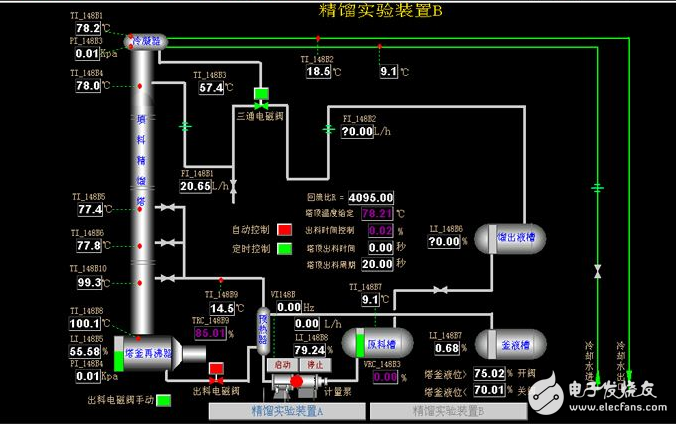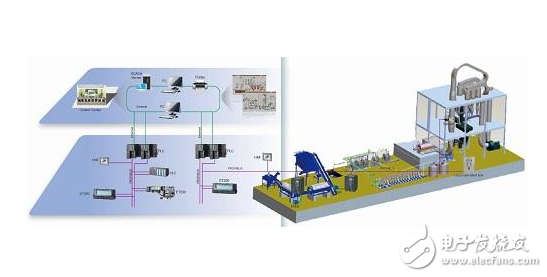The distributed control system is a new-generation instrument control system based on microprocessors, which adopts the control principle of decentralized control functions, centralized display operation, and autonomous and comprehensive coordination design principles. The distributed control system, referred to as DCS, can also be literally translated as "distributed control system" or "distributed computer control system."
It adopts the basic design idea of ​​controlling the decentralization, operation and management concentration, and adopts the structure of multi-level hierarchical and cooperative autonomy. Its main feature is its centralized management and decentralized control. At present, DCS has been widely used in various industries such as power, metallurgy and petrochemical.
Design of DCS control system for alcohol production lineThe distillation section is undoubtedly the most important part of alcohol production. The production of alcohol, wine consumption, energy consumption and many other indicators have a great relationship. In many alcohol production enterprises in China, the distillation process is mainly based on two towers. In terms of instrumentation, most companies use digital display to display parameters. Workers adjust the valve manually according to parameter changes. Although the control requirements can also be met, the labor intensity of the workers is high. When the energy is not concentrated, the control lag is likely to occur, causing large fluctuations in the parameters, affecting the quality of the alcohol or causing the wine to run up and down. In order to improve this situation and stabilize alcohol production conditions, Jinan Zhongrun Automation Control Co., Ltd. and Feicheng Jinta Machinery Co., Ltd. jointly launched the alcohol distillation DCS control system.
In recent years, stimulated by the market situation, domestic new alcohol companies have proliferated, and old companies have also expanded. In order to cope with more fierce market competition, many enterprises have selected three towers, five towers and other multi-tower distillation processes in the distillation process. The increase in distillation detection points and control points places higher demands on the distillation control system. For different process equipment, we have tailored two towers atmospheric DCS control system, three tower atmospheric DCS control system, three tower differential pressure DCS control system and five tower differential pressure DCS control system for different users.
First, the choice of distillation processIn the choice of distillation process, according to the user raw materials, alcohol sales targets, production scale, can be divided into two-tower distillation, three-tower distillation, multi-tower distillation. For the production of general-grade alcohol, it is generally possible to use two-column atmospheric distillation; when the quality of alcohol is high, multi-tower distillation is generally selected.
According to the comparison of steam consumption and power consumption between atmospheric distillation and differential pressure distillation, differential distillation is preferred for multi-tower distillation.
Second, the choice of process detection points and process control pointsBelow, take the five-tower differential pressure distillation DCS control system as an example to briefly introduce the selection of process detection points and process control points.
The DCS control system breaks through the limitation of the number of instrument panel instruments. It can be more flexible and convenient in the selection of process detection points and process control points, and the control form is more diverse.
1. Public part
1.1 Steam control: In the traditional distillation operation, pay attention to "one uniform and four stable". Stable vapor pressure is a prerequisite for ensuring stable alcohol quality. In the five-tower differential pressure distillation DCS control system, the pressure, temperature and flow of steam are measured. The DCS control system makes calculations based on the changes of the measured values, and regulates the steam regulating valve to achieve the purpose of stabilizing the steam pressure.
1.2 Control of circulating water pressure: In alcohol production, the distillation condenser is cooled by circulating water. In the five-tower differential pressure distillation, there are many water equipment. In order to stabilize the alcohol quality and the condenser does not run the wine, we use the variable frequency constant pressure water supply process in the supply of circulating water. At the same time, on the DCS control system, we set the circulating water temperature and pressure detection, and set the upper and lower limit alarms.
1.3 Control of vacuum degree: In the five-tower differential pressure distillation, the crude tower and methanol tower work under negative pressure. The negative pressure state of the system is caused by the vacuum pump, and the vacuum pump continuously draws out the non-condensable gas to maintain the negative pressure state of the system. In order to stabilize the vacuum degree of the system, ensure the independent negative pressure state of each tower, stabilize the operating environment, and set the inlet air at the inlet of the vacuum pump.
Regulating valve. The DCS control system makes calculations based on changes in the vacuum measurement value, and regulates the opening degree of the inlet air regulating valve to ensure the stability of the vacuum.

2, the crude distillation tower system
2.1 Control of the amount of crude distillation tower: In the five-tower differential pressure distillation system, maintaining the stability of the crude distillation column is a prerequisite for maintaining the material balance of the five-column system. For the control scheme of the rough tower, we chose the variable frequency control scheme of the pump. An electromagnetic flowmeter is installed on the crude tower inlet pipe to detect the change value of the inlet and outlet flow. The DCS control system makes calculations based on the flow change results, controls the frequency converter, adjusts the output frequency of the frequency converter, and changes the transition of the inlet pump motor, thereby changing the output volume of the crude tower inlet pump and maintaining the volume of the coarse tower. stable.
2.2 Crude tower liquid level control: The crude distillation tower is operated under negative pressure, and the distiller's grains in the crude tower are discharged from the crude tower by the distiller's juice pump. The crude tower liquid level control scheme adopts the frequency conversion control scheme of the distiller's juice pump. The DCS control system measures the liquid level of the crude tower and calculates it according to the measured value to control the inverter of the distiller's pump.
2.3 Crude wine tank liquid level control: The light alcohol in the crude tower coarse wine tank is driven into the dilution tower through the light wine pump. In the control scheme, we chose the light wine pump frequency conversion control scheme. The coarse pressure tank differential pressure transmitter detects the liquid level change value, and the DCS control system adjusts the output frequency of the light wine pump frequency conversion according to the calculation result, thereby adjusting the liquid level of the coarse wine tank.
3. Dilution tower system
3.1 Dilution tower inlet water control: The diluted hot water of the dilution tower is the wastewater from the refined tower tower, which is sent to the top of the tower by the refined tower wastewater pump. The dilution water must ensure that the flow is stable and adjustable. In the control scheme, we chose the variable frequency control of the precision tower wastewater pump. In the production process, we set the set value of the hot water flow of the dilution tower according to the production situation, the electromagnetic flowmeter detects the change value of the hot water flow, and the DCS control system adjusts the output frequency of the inverter according to the flow change value, thereby The hot water flow is stable within the set range.
3.2 Dilution tower liquid level control: Dilution tower light wine is transported into the middle and lower part of the fine tower through the fine tower feed pump, and the precision tower feed pump adopts the frequency conversion control scheme. The dilution tower tower differential pressure transmitter sends the dilution tower liquid level change value to the DCS system, and the DCS system adjusts the output frequency of the precision tower feed pump inverter according to the calculation result, and adjusts the flow rate of the precision tower feed pump, thereby diluting The Tata tank level is controlled within the set range.
4, distillation tower system
4.1 Distillation tower steam control: The refined tower steam inlet is the main heat source of the whole five-tower system. The stability of the refined tower steam inlet has a great influence on the balanced operation of the crude tower, dilution tower and methanol tower. In order to adapt the refined steam inlet to various parameters, we take advantage of the DCS control system and use the parameters of the bottom temperature, bottom pressure and steam temperature to form a complex control system to jointly control the steam entering the tower. The production practice proves that using the bottom temperature, bottom pressure and steam temperature of the fine tower to jointly control the scheme of the steam entering the tower can achieve very satisfactory results.
4.2 Refined tower tower liquid level control: The refined tower is operated under positive pressure environment, and the tower liquid can be discharged outside the tower by using the internal pressure of the refined tower. We have a regulating valve installed on the drain pipe. The tower kettle differential pressure transmitter sends the liquid level change value of the refined tower to the DCS control system. The DCS control system adjusts the opening degree of the regulating valve according to the calculation result to achieve the purpose of controlling the liquid level of the refined tower.
4.3 Liquid level control of the refined tower steam condensate tank: The refined tower is indirectly heated by the reboiler, which generates a large amount of steam condensed water when heated. The steam condensate enters the steam condensate tank and is then sent to the boiler with a condensate pump. The condensate pump adopts frequency conversion control, and the condensate tank differential pressure transmitter measures the change value of the condensate water tank level. The DCS control system adjusts the output frequency of the condensate pump frequency converter according to the calculation result, so that the liquid level of the condensate water tank is maintained. Within the range.
4.4 Dilution control of distillation tower: According to the experience of self-control of alcohol production for many years, we have selected the temperature control of the middle temperature, medium temperature, middle temperature, top temperature and temperature of the fine tower, and the variable flow of the wine flow to form a complex control system to control Fine tower to take wine. The parameters of the medium temperature, medium temperature, medium temperature, top temperature, and wine flow rate of the refined tower are sent to the DCS control system. The DCS control system calculates, compares, and judges according to the mathematical model of the memory, and calculates the opening degree of the regulating valve. The fine wine can be used to cope with the changes of various parameters, and the unmanned operation of taking the wine is achieved.
5, recycling tower system
5.1 Recovery tower feed tank liquid level control: For the control of the recovery tower feed tank liquid level, we have adopted the cascade adjustment of liquid level and flow rate. During the control, the feed stream of the recovery tower is the main variable, and the liquid level of the recovery tower feed tank is used as the auxiliary variable, and the recovery tower feed pump is controlled by the frequency conversion.
5.2 Recycling tower liquid level control: A regulating valve is installed on the waste water line of the recovery tower. The tower kettle differential pressure transmitter sends the liquid level change value of the tower to the DCS control system. The DCS control system adjusts the opening degree of the regulating valve according to the calculation result to achieve the purpose of controlling the liquid level of the tower.
5.3 Recycling Tower Picking Wine: The recycling tower takes the wine control according to the PID control of the recovery tower temperature.

1. DCS system hardware composition: The DCS system hardware consists of control system and monitoring part. The control system selects the CPU series of S7-400, and the monitoring station consists of three upper computers. The three upper computers are equipped with DELL computers and three 20′′ liquid crystal displays to form a monitoring system. The three upper computers are one engineering station, two operator stations, and the engineering station can double as an operator station. In this way, we are in the control room. On the display, you can monitor three different screens simultaneously.
2. Configuration software: In the selection of configuration software, according to the user's technical strength and usage habits, you can choose Kingview or WinCC configuration software.
3. Introduction to control screen:
3.1 Process Flow Chart: There are many equipments for the five-tower differential pressure system, and there are many detection and control points. It is impossible to display all the equipment and parameters on one screen. We divided the five-tower differential pressure system into three display screens: coarse tower and vacuum control system, dilution tower and refined tower system, methanol tower and recovery tower system. These three process pictures can be displayed on three displays simultaneously. The process picture is the main picture that we monitor during the production process. On the process flow screen, the process equipment and pipelines constitute the process flow according to the relative position, and the detection control points of each equipment and pipeline are also arranged on the process flow screen according to the relative position. Each process detection point appears in the form of digital quantity on the monitoring screen. Each control parameter has a window opening menu function, which can be easily opened and closed by the mouse. The mouse can be used to easily adjust various control parameters and adjust the opening of the inverter or regulating valve.
3.2 Parameter list screen: In the five-tower system, there are many parameters, which cannot be displayed on one display screen. To do this, we set up the parameter list screen. On the list screen, all the parameters are displayed in digital form, the whole picture is arranged, some are similar to the traditional dashboard. For the parameters that need to be controlled, the click window function is set, and the window can be opened with the mouse to adjust the control parameters.
Silicon TVS / TSS:
Diode TVS (Transient Voltage Suppressor), also known as Transient suppression diodes, is widely used a new type of high efficient circuit protection device, it has a fast response time (the nanosecond) and high surge absorbing ability.When it ends of stand moments of high energy shock, TVS can bring the two ends at high rate from high impedance to a low impedance between impedance values, to absorb a large current moment, put it at both ends of the voltage restraint on a predetermined value, thus protecting the back of the circuit components are not affected by the impact of the transient high pressure spikes.
Silicon TVS Transient Voltage Suppresso,Silicon TSS Transient Voltage Suppresso
YANGZHOU POSITIONING TECH CO., LTD. , https://www.cnfudatech.com
